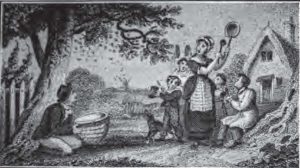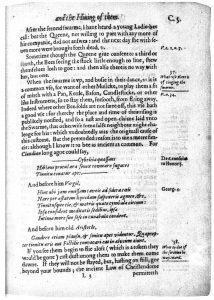By: James E. Tew
Should I apologize?
Should I immediately apologize for spending your reading time on an antiquated subject like “tanging” while other writers – in this very publication – are properly writing informative and current pieces for your beekeeping edification? In my defense, my involvement in this legacy swarm management topic started innocently enough and, ironically, some of my beekeeper friends caused it. In a real way, this saga is not my fault.
A wearying zoom presentation
Last April, I presented a zoom talk on swarms and swarm biology to the Broward County Bee Club in Florida – an energetic and organized group. I thank you for inviting me. Though the group was engaged and supportive, it has been my sense that, after a short time, most Zoom talks have a numbing effect on the brains of both the listeners and the presenter. Try as I might, as the Broward session went to Q&A, I had the typical unfulfilled sense that somehow, I had not done my job as a presenter, and I just hate that feeling.
Though the group was engaged and supportive, it has been my sense that, after a short time, most Zoom talks have a numbing effect on the brains of both the listeners and the presenter. Try as I might, as the Broward session went to Q&A, I had the typical unfulfilled sense that somehow, I had not done my job as a presenter, and I just hate that feeling.
I don’t remember who did it…
Since the topic had been on honey bee reproductive swarming, and since we had previously discussed the frustration of losing a swarm, either I or someone else mentioned “tanging” a swarm before it escaped. It’s an old recommendation to tang the swarm to get it to settle.
Several participants had no opinion, but several did have strong beliefs that tanging did work – and it worked dependably. I admitted to the group that night, as I admit to you readers now, that I have no technical information that could explain how this old process works or why it would work. At the time, I was caught unawares and after thinking for a few days, I convinced Kim Flottum that we should use one of our podcast segments at Honey Bee Obscura to discuss the swarm concept of tanging.
The results of our tanging podcast were much like the earlier experience I had in Florida. Beekeepers who believe in tanging, devoutly believe in it. We had follow-up communication with experienced beekeepers who wanted to be on record as being “tangers.” They tang and they recommend it.
A primer on tanging a swarm
In today’s language, a simple definition of the process would be a swarm is tanged when noise – usually made with metal pieces such as a metal pan being struck with a metal spoon – is produced near the moving swarm. It is generally thought that a swarm cannot be prevented by tanging, but it can be convinced to “pitch” (or land) at a nearby location. Believers feel that the tanged swarm will come down – or at least – will usually come down. No one has said to me that all swarms come down all the time. On the other hand, unbelievers feel that nothing is changed by implementing the noise-making process, and that the swarm either lands – or not – on its own.
Here’s the enduring tanging quirk – there have been believers and unbelievers for hundreds and hundreds of years. Yet, this concept has clearly not passed into history. It perseveres. Does this process work or not?
The Hive and the Honey Bee and ABC & XYZ of Beekeeping
The two hallmark books of U.S. beekeeping, The Hive and Honey Bee and ABC and XYZ of Beekeeping have insightful input (or not). So far as I could find, the current Hive and the Honey Bee makes no mention of the procedure – at all. If the procedure was invaluable in its deployment, and established in beekeeping lore, would not this respected book have contained detailed information?
Authors of the ABC and XYZ of Beekeeping, wrote, “There is no evidence that tanging has any effect on swarm behavior, although some beekeepers still believe that it does.” As is the usual case, the ABC & XYZ author presented the justification for tanging a swarm was to keep it in sight and retain ownership of the mobile swarm as it crossed property lines.
Nearly 400 years ago
In 1623, Charles Butler wrote “The Feminine Monarchie: or The Historie of Bees. In chapter five of his book, he discussed tinging the swarm. He did not use the more recent term, tanging. Still other authors, eons ago, used the word tinkling in lieu of tanging or tinging.

Engraving of a swarm tanging event. nearly 200 years old.
As best I can translate Old English to English, beginning at the third paragraph of Butler’s work, in the reproduction that I have presented in this article, he wrote the following description:
When the swarm is up, and busy in their dance, it is a common way, for want of other music, to play them a fit of mirth with a pan, kettle, basin, candlestick, or other like instrument, for to stay them, forsooth, from flying away. Indeed, where other bee-folds are not far off, this way hath a good way: for thereby, the place and time of their rising is publicly noted, and for a clear and open claim laid unto the swarm that otherwise some neighbor might challenge for him, which undoubtedly was the original cause of this custom. But the pretended reason is to me a mere fancy: but I know it to be as ancient as common. (At this point, Butler includes several comments made by much earlier scholars and writers – all relating to tanging and in other languages. In fact, in other publications, references are made to Columella describing tanging 500 B.C. Pliny (AD 23-79), Virgil (BC 70-19), and Claudian (c. 370-404) instructed swarm chasers to “strike brazen vessels.” (This process of striking metal vessels to bring down a swarm is clearly a very, very old swarm-gathering recommendation.)
Butler continued: If you see them begin to fly aloft, which is a token that they would be gone, cast dust among them to make them come down. If they cannot be stayed, hastening on still, go beyond your bounds, the ancient laws of Christendom permits you to pursue them, where to fore, for the recovery of your own. Notwithstanding, do what you can, sometimes they will away, and perhaps fly too far before they settle, that though follow them never so fast, you must be content to leave them happily to the happy finder. For when you have lost the sight and hearing of them, you have lost all right and property in them (JTew bolding).
Yet another older literature review on tanging
Harrod-Hempsall1 published a thorough discussion of tanging in volume one of his two-volume beekeeping tome, Bee-Keeping, New and Old. He cited John Keys2 who, in his earlier 1814 book, Treatise on Breeding and Management of Bees, gave explicit support to “tinkling” bees and offered several specific recommendations that I present below.
“If prime swarms, were not in the habit of settling in a usual spot, would most likely be lost by the “apiator” if not tinkled.”
Secondly, “For prime swarms (first swarms), the noise should not begin till such a quantity of bees have arisen as will for a good swarm, for fear of terrifying the princess (JTew comment: the queen) from issuing; and if so, all the bees will return, though hived.”
Thirdly, “The noise should be made on the contrary side to that which will be most proper for settling.” (JTew comment. Essentially, tang on the opposite side of the swarm at the site where you would like them to settle.)
Fourth, “Nor should it (tanging) continue longer than the bees begin to cluster; there is no danger, but the rest will follow on hearing their buzz.”
Fifth, “The greater the noise, the sooner it (JTew comment: tanging) is likely to succeed. I find a watch rattle (used about London) the most efficacious, and that when the common method has failed.”
A watch rattle is a noise ratchet. It was used by British and later, also used by US police, as a noise maker for attracting both attention and other police persons. It now has musical uses or sound effect uses. Also, I have seen children’s’ toys that were similar rachet devices. The watch rattle is nicely explained and shown at: https://www.youtube.com/watch?v=BViVjh9mTeU.
Harrod-Hempsall wrote that the during the last century, it was felt that an iron frying pan and door key were the most efficacious tanging instruments. Obvious, this was the large, heavy keys much like the ones that always hang on the wall in jails in old western movies, and not the little flimsy key that I have in my pocket at this very moment.
Harrod-Hempsall wrote that John Keys presented very full instruction, “but they contain the only valid reason for tanging, viz., as a means of claiming the swarm.”
The swarm, the law, and polite society
What if you saw a swarm issue from your colony and settle on your neighbor’s property? Then, what if, you watched that neighbor put what had been your bees in a hive box of his? What would you feel? Rest assured that such feelings were long ago experienced by others. As is so often the case, the law has a long history of involvement in determining, “who owns the transient swarm?”

Tanging description from Butler’s 400-year-old book.
I am in no way qualified to write about legal ramifications, so I cite some dated (and tedious) material from Harrod-Hempsall on this subject. At the time, British law was based on Roman law. Roman law designated honey bees as ferae naturae – being of a wild nature – and were res nullius or belonging to no one. So, let’s say that I hive a swarm, ferae naturae, and I confine it (so much as possible), so they do not escape and reclaim their natural liberty. If they abscond or swarm again, and regain their natural liberty, my ownership of the swarm immediately ceases.
Readers, at this point, things really become contorted. Apparently, a summary of the situation could be that I have wild animals (bees) in a box on my property. They swarm, and I see them go. I make noise to alert others. The bees are mine so long as I can keep them in sight and so long as others confirm that the bees were mine. Maybe the bees, which I have kept in sight, land on a tree not on my property. Though they continue to be my bees, I am not free to trespass at will. Essentially, my wild animals are near to regaining their natural liberty, but by doing so, the ownership of the bees is now ratione soli (by reason of the soil). The person who owns the soil on which the tree stands becomes entitled to the bees. From above, I cite Butler again, “For when you have lost the sight and hearing of them, you have lost all right and property in them.” If they have been kept in sight, a claim of ownership could be justified. As it were, the bees have simply temporarily gone astray.
Harrod-Hempsall wrote, “When an action is fought, much depends on the attitude of the Judge with regard to defining the law, circumstances vary, and points which are debatable crop up.” He finished his comments by admonishing the reader that it was better to sacrifice the swarm than to go to the law.
My reason for putting you through this discussion.
The legal issues surrounding lost swarms and ownership, in years past, were complex and complicated. Bee skeps were common and provided essential components for life. Swarms were coveted both then and now. Indeed, swarms were valuable enough to hire either the very young or the very old to watch for issuing swarms.
When the swarm did finally issue, noise was made to alert the community that bees were on the move and to maintain visual record of the bees in order to defend ownership when landing on the property of others. Though I have never read this, I know that the noise would also alert others to help watch for the directional movement of the swarm – or worse – alert others to deviously try to capture the swarm.

Butler telling the reader, when you have lost sight and sound, you have lost all rights to the swarm.
Don’t blame the messenger
Herrod-Hempsall bluntly wrote, “The noise made by tanging has no effect whatever upon swarming bees, therefore, instead of wasting time and annoying neighbors by making an abominable din, advantage should be taken of the known habits of bees.”
Some good news
Realizing that after hundreds and hundreds of years, no one’s current mindset has been changed on this subject by my comments, I can confidently say that tanging a swarm does no harm. In the excitement of the swarm meandering along, at least it is something to the “apiator” can do while the swarm is in motion.
Whether or not tanging works, when beekeepers use noise to entice a swarm to settle, they are employing an ancient method that has been passed through many generations of earlier beekeepers. At that swarming moment, you are feeling what so many other now departed beekeepers have felt. You are “in the moment.” Feel free to tang. At least you are doing something.
Dr. James E. Tew, Emeritus Faculty, Entomology, The Ohio State University and, One Tew Bee, LLC; tewbee2@gmail.com; http://www.onetew.com










